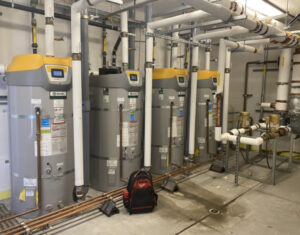A failing water heater can cause fluctuating water temperatures and can even cause fires. It is vital to call a plumber if you notice these problems. A faulty water heater can cause flooding and even a fire if it is not installed properly. Fortunately, there are a variety of different plumbing services that can help you. In addition to providing quality water heater installation, we also offer financing and unmatched guarantees. Our technicians will even install water heaters on the same day.

First, you need to install a new temperature and pressure relief valve. A temperature and pressure relief valve is attached to the tank using Teflon tape. A copper discharge pipe is then attached to the tank. Make sure the tank is level, and that the pipes are properly attached. You can also use a masonry bit to create a pilot hole. Finally, you need to screw the copper discharge pipe to the tank. Follow the manufacturer’s instructions for installation.
Installing water heaters requires various plumbing tools and fittings. The nipples are attached to the cold water pipe and the hot water outlet. These fittings make repairs and replacements easy. Using male-threaded adapters is a good idea. The nipples fit between the male-threaded adapters. Then, coupling nuts are screwed onto the adapters. Make sure the nipples are securely attached to the water heater before you begin the installation.
Venting is another important part of water heater installation. Direct venting allows for fresh air to circulate inside the house, and in many places, it is required by building code. Direct venting is also best for air-tight homes because it prevents the buildup of gases in the home. If you are concerned about the air quality of your home, you can install a powerful fan to help channel exhaust gas and fresh air out. These heaters must be vented according to the manufacturer’s instructions.
A plumber will typically quote a flat rate for water heater installation and will estimate how long it will take them to install the unit. Most water heaters take one to four hours, while tankless water heaters take more time. You should always consider the time to install a water heater, as the time involved can quickly double the project’s cost. If you’re handy with your hands, you can install a water heater yourself.
After water heater installation, make sure the shutoff switch is in a location where you can see it easily. You can also install a circuit breaker near it or a separate electrical disconnect switch. A shutoff switch is an essential part of water heater installation. A good plumber knows how to handle a water heater installation and can help you to avoid a potentially disastrous situation. And while you’re at it, don’t forget to use a non-contact voltage tester to ensure that the circuit is safe.
It is important to check the local building codes for water heater installation. Many cities follow the International Code Council models when it comes to residential and commercial building codes. It is crucial that you get a permit before installing a water heater or replacing an existing one if you have one. Your local municipality may also require you to pass inspections after the installation. If the water heater installation is not completed properly, the inspector will call you to get it fixed.
While professional installation is the most affordable option, the cost of labor can still add up if it’s difficult to reach a certain area. Some homeowners will choose to perform their water heater installation. But do keep in mind that this is an advanced project and requires plumbing and electrical skills. Beginners should avoid it unless they’re skilled in these fields. But, if you have experience and a DIY mindset, it’s worth a try.
